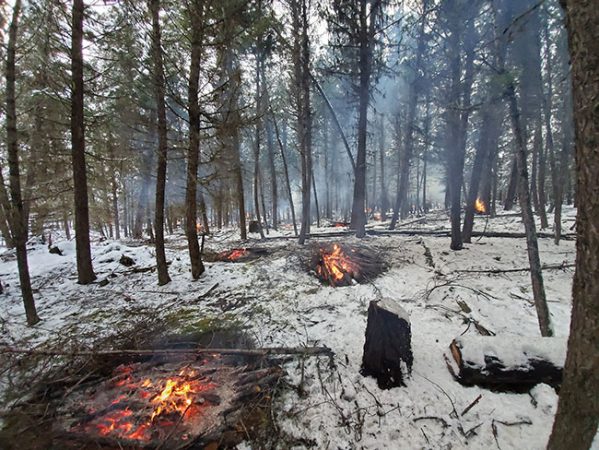
Features
Forestry Management
Harvesting
BC research: Eliminating wildfire risks through harvesting techniques
Logging project looks to reduce wildfire threat near urban areas
April 3, 2020 By Silvia Cademartori
 Alkali Resource Management (ARM) conducts fuel management around the homes in the Esk’etemc First Nation community just south of Williams Lake, B.C. Photo courtesy ARM.
Alkali Resource Management (ARM) conducts fuel management around the homes in the Esk’etemc First Nation community just south of Williams Lake, B.C. Photo courtesy ARM. Scientists in FPInnovations’ wildfire operations research and fibre-supply groups are combining their expertise in a joint research project with the city of Quesnel, B.C. – funded in part by the Forest Enhancement Society of British Columbia – to better understand how harvesting techniques can reduce hazardous vegetative fuel to lower the threat of disastrous wildfires near urban areas while preserving a forest’s ecosystem.
The research site is adjacent to the Quesnel Airport in a heavily-treed area with organic material above, beneath and on the forest floor, making it a rich forest-fuel environment. FPInnovations’ involvement is part of its broader work on wildfire research.
Researchers Steven Hvenegaard and Marian Marinescu were on-site in late September to map out test plots over the 29-hectare area. They captured data on fibre type, duff layer, stand structure, soil type and fuel loading. The pre-harvest fuel inventory is being followed-up by a productivity study of the harvesting process led by researcher Peter Dyson.
Once completed, the project will contribute to the knowledge of predicting the spread and intensity of wildfires based on on-site fuels.
Relevant research
“Studies like this are growing in relevance due to the continuing threat of wildfire to communities and the need to conduct fuel treatments in the wildland-urban interface in a cost-effective manner,” Hvenegaard says. “Documenting this fuel treatment will inform fuels managers on the value of these fuel-treatment techniques in achieving community protection goals.”
Hvenegaard and Marinescu measured fuel loading in all the fuel layers in the test area. In the aerial layer, stem density, diameter at breast height and crown base height of trees were measured. On the surface layer, woody debris was measured and other surface fuels, such as grass and shrubs, were characterized. In the ground layer, litter and duff depth were measured.

Wildfire risk reduction projects are becoming a greater focus for many communities. Esk’etemc First Nations-owned ARM recently underwent a wildfire risk reduction project in the Williams Lake Community forest. Photo courtesy ARM.
Fine fuels, such as grass or needle litter on the surface layer, can create a high potential for ignition from natural causes, such as lightning, or from human activity. Light flashy fuels, such as feathermoss and lichens, combined with medium-sized fuels, such as dead and down debris, can cause fires on the surface layer to spread to ladder fuels, such as lower branches, and cause an intermittent crown fire.
Members of the Kluskus and Esk’etemc First Nations assisted with the pre-harvest assessment protocols with the goal of undertaking fire-mitigation projects in their respective communities. Their participation was made possible in part by FPInnovations’ B.C. Indigenous Forest Sector Technical Support Program, which encourages the economic and social independence, as well as the environmental sustainability of Indigenous communities in B.C.
Outside-the-box harvesting
“The forest-fuel treatment in this environment uses an innovative combination of timber-harvesting techniques and surface-fuel removal methods,” Hvenegaard explains. “We will document all phases of the project to assess changes in the fuel environment and their impact on potential fire behaviour.”
As part of the forest-fuel treatment plan, an Eco Log 550D harvester equipped with a Log Max 4000 harvesting head thinned from below, harvesting merchantable volume as well as piling debris and non-merchantable stems. This rare practice saw the piling of merchantable stems on one side of the thinning trails and branch stems, tops and non-merchantable pieces on the other side.
The usual method is to place stems and branches in front of the machine to act as a brush mat. Capturing the additional time the harvester takes to complete the task will be part of assessing important harvester productivity, whereas removing the non-merchantable pieces with a forwarder will provide valuable information on productivity and operator techniques.
These selective-harvesting methods target smaller stems for harvest and keep larger, mature stems that are more fire-resistant. Mature Douglas fir stems will remain on the site because they develop a thick bark and have a high crown base height.
Research by FPInnovations’ wildfire operations research and fibre-supply scientists identifies better approaches to wildfire management that allow communities to invest in effective fuel-treatment plans.
For more information on the Quesnel airport project or the company’s wildfire research, contact Greg Baxter at Greg.Baxter@fpinnovations.ca.
Silvia Cademartori is a communications writer for FPInnovations.
Print this page